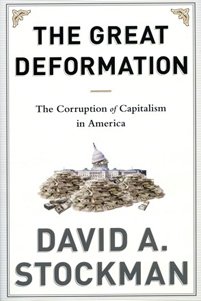Jacques Rueff was notoriously unafraid to speak economic truth to politicians of all persuasions—and we should heed his insights.
David Stockman's Informed Anger
David Stockman is probably most well-known for his service as the first Director of the Office and Management and Budget under President Reagan. For those following politics at the time, the most vivid memory was likely when Reagan reportedly took Stockman “to the woodshed” after he, without clearing it with the President, spilled his guts to a reporter from the Atlantic Monthly about the inner workings of the budget process in the Reagan White House. Shortly after departing from the Reagan Administration, Stockman wrote a top-selling book, The Triumph of Politics, a book which I purchased in the late 1980s and still have on my book shelf, but somehow never got around to reading.
Stockman disappeared from the Washington policy world after the publication of his book, apparently made a great deal of money as an investment banker and investor, and did not have much to say on the public policy front for about 25 years. However, he started appearing on the cable business channels over the last few years as a commentator in the lead up to the release of his book early this year. What his book, The Great Deformation—which in contrast to The Triumph of Politics I can now say I have read—reveals is someone who has repressed his anger at the unfolding of repeated sessions of easing by the Fed on the monetary side and by Congress on the fiscal side. The easing comes as part of a cycle of bubbles inflating, bubbles bursting, and then bailouts of one sort or another. Stockman traces these cycles during the mid-1980s; the late 1990s; the early 2000s; and the most recent financial crisis of 2007 to 2009. One commentator has called his book, the ranting of a “cranky old man.” But, in keeping with the title of the book, Stockman argues that the financial markets are now so ‘deformed’ by the distortions of government intervention that our fiscal and financial fortunes will most assuredly get worse, unless his dramatic prescriptions at the end are adopted.
In case you were not aware of this fact, Stockman was indicted for fraud related to one of his business investments and he weaves this fact into the storyline, engaging in a bit of introspection about how this indictment led him to recognize the market distortions going on about him in the financial industry and this revelation led to chronicling these events in his book: “Indeed, it was only after my own crash landing on the shoals of excessive leverage that I came to recognize the Great Deformation.”
To get straight to the point, if you like a book that summarizes the historical goings on in the financial industry and in fiscal policy since the Nixon administration from a mostly free market perspective, told in a folksy and snarky manner with colorful language and name-calling sprinkled throughout, but lacking much in the way of detailed citations to the specifics, then you will probably like Stockman’s effort. However, even if the prospect of a book with these characteristics appeals to you, you may not want to take the time required to make it through this massive tome of 700+ pages.
To me this verbosity indicates a weak editing job by the publisher, who was apparently unwilling to apply more discipline to author Stockman who tends to spend a great deal of time detailing points that are not necessarily directly linked to his core thesis. The book could easily disgorge itself of 200 or more pages without reducing the forcefulness of the arguments. In fact, the length of the book apparently taxed the editor’s ability to stay focused, as numerous typographical and grammatical errors are evident throughout the book, as well as misstatements of fact that would have been caught by simple fact-checking (President McKinley was never a senator and Fed Governors Angell and Mishkin were never vice chairs of the Fed’s Board of Governors).
A further point on the editing and style is that Stockman uses the following words and phrases incessantly throughout the text: ‘financial engineer,’ ‘bubble,’ ‘Greenspan/Bernanke Put,’ ‘double down,’ ‘Eccles Building,’ ‘parabolic’ and ‘off the charts.’ If someone asks you to join a college-style drinking game where you have to read Stockman’s book and have a drink every time he utters one of these phrases, don’t do it as you won’t live through the experience.
Another annoyance about Stockman’s style is the absolute lack of direct documentation of his policy arguments. Most recent books on financial crises and their history have endnotes at the back that document in a few dozen pages the direct citations for the book. Examples include Andrew Ross Sorkin’s Too Big to Fail (39 pages); Sheila Bair’s Bull by the Horns (22 pages); Neil Barofsky’s Bailout (21 pages); and David Wessel’s In Fed We Trust (26 pages). I don’t know about you, but when I read a book I usually want to dig deeper into an author’s sources. You are out of luck with Great Deformation as Stockman declares in the book’s final chapter that “…the book is not footnoted because my purpose has been to interpret and pattern the facts, not to discover or explicate them.” In a similar vein, if you like the clarity of a good chart or graph to bring home a point, you are out of luck again, as according to Stockman: “The factual material in the book is presented to illustrate, frame or document my themes, but not to detract from the flow of the argument owing to inordinate detail or spurious precision. For that reason, the book is also free of charts and graphs.”
I must also say there is a lot to like about the book. It is a detailed summary of the last 40 years of economic and financial history, with the vast majority of the book covering events after the evil Nixonian closing of the gold window in the early 1970s. There are a few sidebar references to earlier events, such as the Panic of 1907, the Great Depression, and Eisenhower’s efforts to impose fiscal discipline, but most of the focus is on more recent history. Particularly good sections include those on the ‘warfare state’ as Stockman calls it; his ‘insider’ critique of the Reagan budgets; and the Eisenhower efforts to simultaneously reign in both welfare and warfare spending to balance the budget.
His analysis of the most recent crisis, including a critique of Bernanke’s depression mongering; the juicing of the homeownership rate through government policy that inflated the housing bubble; and a brief history of the buildup of Fannie Mae and Freddie Mac in the years before the crisis are good, although there is not much here that is particularly new or earth-shattering. I do have to say I like his critique of some of the political hacks who were woefully unqualified for their jobs in the Bush 43 Administration, such as Paulson deputy Neel Kashkari, who led the Treasury Office of Financial Stability, as well as the TARP program.
However, it is more than a little disappointing that Stockman did not spend too much time on the most recent crisis. Early on in the book, Stockman traces through bits and pieces of the history of what he calls the “Blackberry Panic of 2008.” But I expected a great deal more discussion at the end of the book also as it traced the events of the past 40 years in roughly chronological order. He never does go into too much detail other than in those early chapters. So if you are looking for a highly detailed analysis of the 2007 to 2009 crisis you are not going to get it in Stockman’s book.
Another curiosity is when Stockman runs through a list of villains and heroes of the Great Deformation. Most of this list makes sense and the villains are those you would expect, the people we all like to dislike: Roosevelt, Nixon, Greenspan, Paulson, Geithner, Rubin, Bernanke, Bush 43 and Obama, among others. What is really strange is the list of ‘heroes.’ These include former FDIC chairman Sheila Bair and President Hoover. Maybe Stockman just isn’t aware of the true facts, but Bair actually led the FDIC Board in multiple bailouts of financial institutions (the bailouts Stockman disparages throughout the book), including for Wachovia, Citi, Bank of America and the broad-based FDIC debt guarantee program. But, what is even more curious is the label of Hoover as a ‘hero,’ as Stockman himself even points out in his book that Hoover initiated the bank bailout program of the 1930s, the Reconstruction Finance Corporation, which he refers to as “a paragon of crony capitalism.” For a study in contrasts between President Coolidge and the interventionist Hoover, see Amity Schlaes’ recent book, Coolidge.
So in conclusion, if you are going to spend a lot of your free time over a month reading Stockman’s book (which I did), I would say the only way it is worth it is if you really are in need of a smart summary of the past 40 years of bubbles inflating, bubbles bursting, and government rescuing over that timeframe from a mostly libertarian, free-market perspective. There are exceptions, including Stockman’s insistence that the federal safety net is absolutely necessary and needs to be shored up and refocused. If you don’t need such a primer, it makes much more sense, if you do want a good flavor of Stockman’s opinions on these matters, to just drop “David Stockman book” in YouTube and spend a few hours watching his various appearances on cable TV and other platforms. The best of these is a Reuters sponsored hour long standoff between Stockman and Peter Orszag, a true Obama statist. Stockman lays out all his standard arguments from the book. If you really love his approach and style upon that viewing and desire more like it, then by all means read this book.


